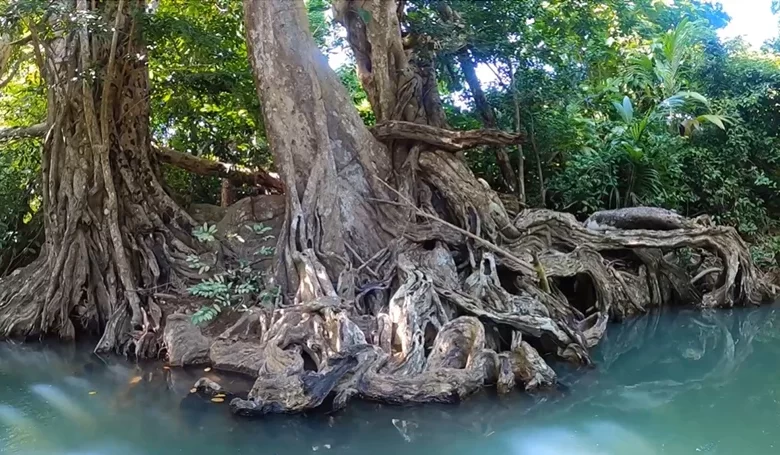Mangrove Swamps of Dominica

The mangrove swamps of Dominica are critical coastal ecosystems that play a vital role in maintaining the island’s biodiversity, protecting shorelines, and supporting local livelihoods. Found primarily along the west coast and east coast, these unique wetlands act as natural buffers against storms, nurseries for marine life, and carbon sinks that help mitigate climate change.
Geographic Distribution of Mangroves in Dominica
Mangrove swamps in Dominica are distributed across several key coastal areas:
- Indian River Mangroves: Located near Portsmouth, this is the largest and most well-known mangrove system, offering rich biodiversity and eco-tourism opportunities.
- Soufrière Bay: Home to fringing mangroves that protect coral reefs and support marine life.
- Layou River Estuary: Features mangrove patches that stabilize the coastline and provide habitat for various species.
- Grand Bay and Geneva Mangroves: Smaller but ecologically significant, these areas help prevent coastal erosion.
Biodiversity: Flora and Fauna
Dominica’s mangroves support an extraordinary range of plant and animal species. The dominant flora includes the Red Mangrove (Rhizophora mangle), known for its stilt-like roots thriving along the water’s edge, and the Black Mangrove (Avicennia germinans), found slightly inland with aerial roots adapted for gas exchange. Further inland, the White Mangrove (Laguncularia racemosa) flourishes, often on the drier edges of the swamps.
In addition to the rich plant life, these mangrove ecosystems provide habitats for numerous fauna. Fish species such as snappers, groupers, and barracudas find refuge here, especially during their juvenile stages. Crustaceans like crabs, shrimp, and molluscs thrive in nutrient-rich waters. Bird species, including the Green Heron, Mangrove Cuckoo, and Osprey, are commonly sighted, while reptiles such as iguanas and amphibians, like frogs, contribute to the area’s ecological diversity.
Ecological Importance
The ecological significance of Dominica’s mangroves extends beyond biodiversity. These swamps act as natural barriers, reducing the impact of storm surges, waves, and coastal erosion, which is especially critical for protecting coastal communities from hurricanes and tropical storms. They serve as powerful carbon sinks, storing large amounts of carbon in their biomass and the soil, thus playing an essential role in climate change mitigation.
Mangrove roots also trap sediments, filter pollutants, and improve water quality, which benefits adjacent coral reefs and seagrass beds. Moreover, these ecosystems serve as vital nursery grounds, offering shelter and breeding areas for many marine species and supporting local fisheries.
Cultural and Economic Significance
Many of Dominica’s coastal communities are vital to local fisheries, providing breeding grounds and nurseries for commercially important fish species that support livelihoods. Eco-tourism activities, such as the popular guided boat tours through the Indian River Mangroves, attract visitors and contribute to the local economy.
Beyond economic value, mangroves hold cultural significance. Traditional knowledge and practices related to mangrove ecosystems are passed down through generations. Some mangrove species are even used in conventional medicine, while their wood is occasionally harvested for construction and artisanal crafts, though this is increasingly regulated to prevent overexploitation.
Threats to Mangrove Ecosystems
Despite their importance, Dominica’s mangroves face several threats:
- Coastal Development: Urbanization and infrastructure projects often lead to habitat loss and fragmentation.
- Pollution: Agriculture, sewage, and plastic waste runoff degrades water quality.
- Climate Change: Rising sea levels and increased storm intensity threaten mangrove stability.
- Unsustainable Resource Use: Overharvesting of wood and overfishing can disrupt mangrove ecosystems.
Conservation Efforts
Recognizing the vital role mangroves play, Dominica has implemented several conservation measures. Many mangrove areas are protected under marine reserves and national parks, ensuring legal safeguards against destructive activities. Community involvement is also pivotal, with local groups actively participating in mangrove restoration projects and environmental education initiatives to raise awareness about the importance of these ecosystems.
Government initiatives led by the Forestry, Wildlife and Parks Division promote sustainable management practices. At the same time, international partnerships with organizations like the Caribbean Biodiversity Fund provide technical and financial support for conservation projects. Restoration efforts focus on replanting degraded areas, monitoring mangrove health, and enhancing resilience against climate change impacts.
Sustainable Tourism and Mangroves
Mangroves are central to Dominica’s eco-tourism offerings:
- Indian River Tours: Guided boat rides through lush mangrove corridors, offering a close-up view of rich biodiversity.
- Bird Watching: Mangrove habitats attract enthusiasts to observe rare and migratory species.
- Kayaking and Paddleboarding: Eco-friendly water sports provide low-impact ways to explore mangrove environments.
These sustainable tourism practices enhance visitor experiences and generate revenue that supports local communities and conservation efforts.
The Way Forward
A multifaceted approach is essential to ensure Dominica’s mangrove swamps’ continued health and sustainability. Enhancing legal protections through stronger environmental regulations can safeguard critical habitats from unchecked development. Promoting sustainable practices within both tourism and fisheries will help maintain ecological balance.
Public awareness campaigns and educational programs can foster a deeper understanding of mangroves’ ecological and economic value among local communities and visitors. Expanding restoration efforts, including replanting degraded areas and implementing long-term monitoring programs to track ecosystem health and resilience, is also crucial.
A Legacy of Resilience
Dominica’s mangrove swamps are more than just natural landscapes; they are dynamic ecosystems that sustain biodiversity, protect coastal communities, and enrich cultural heritage. As the island continues its journey toward environmental resilience and sustainable development, preserving and restoring its mangrove ecosystems will remain a cornerstone of this mission. By valuing and protecting these critical habitats, Dominica secures its natural heritage and strengthens its resilience in environmental challenges.




